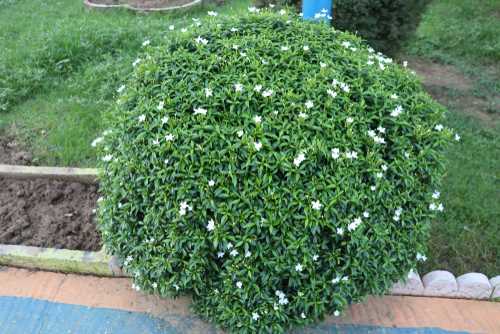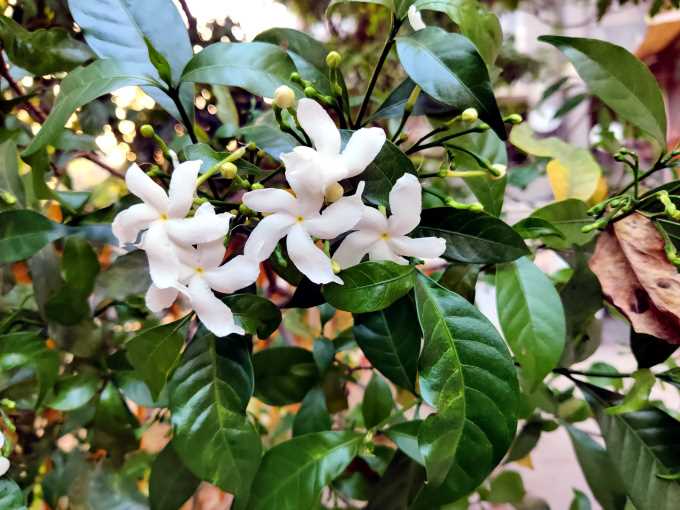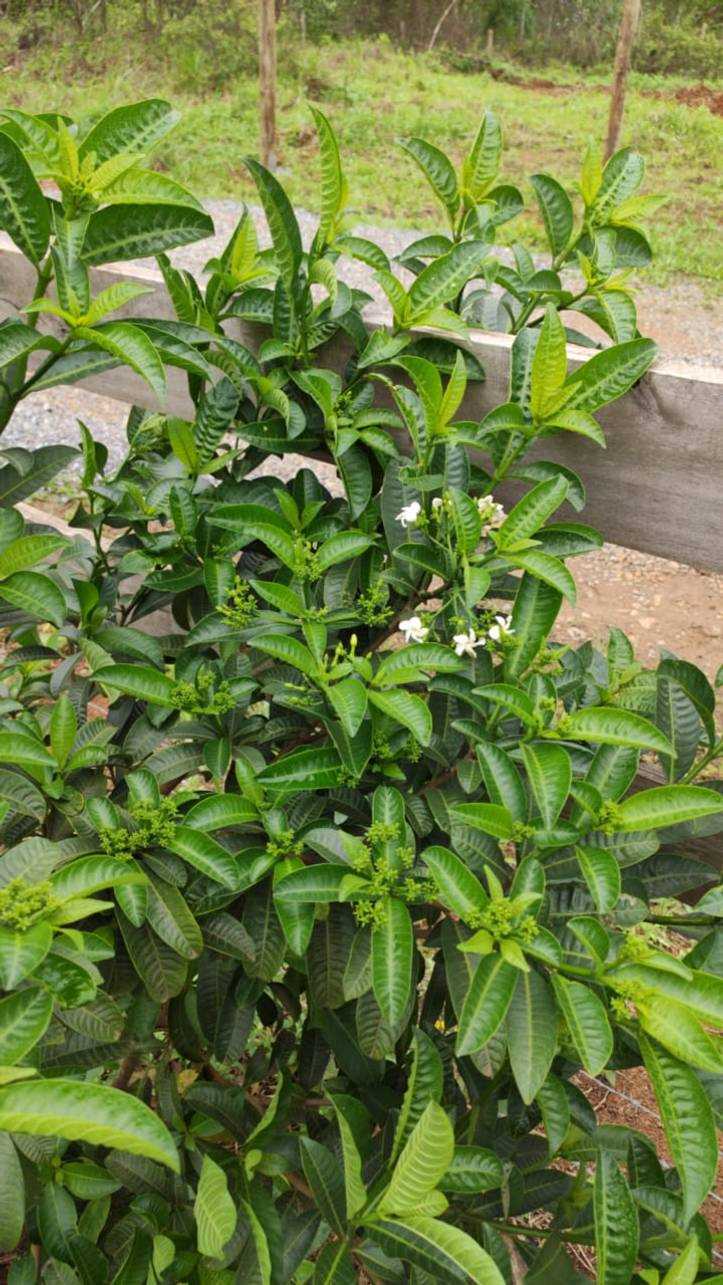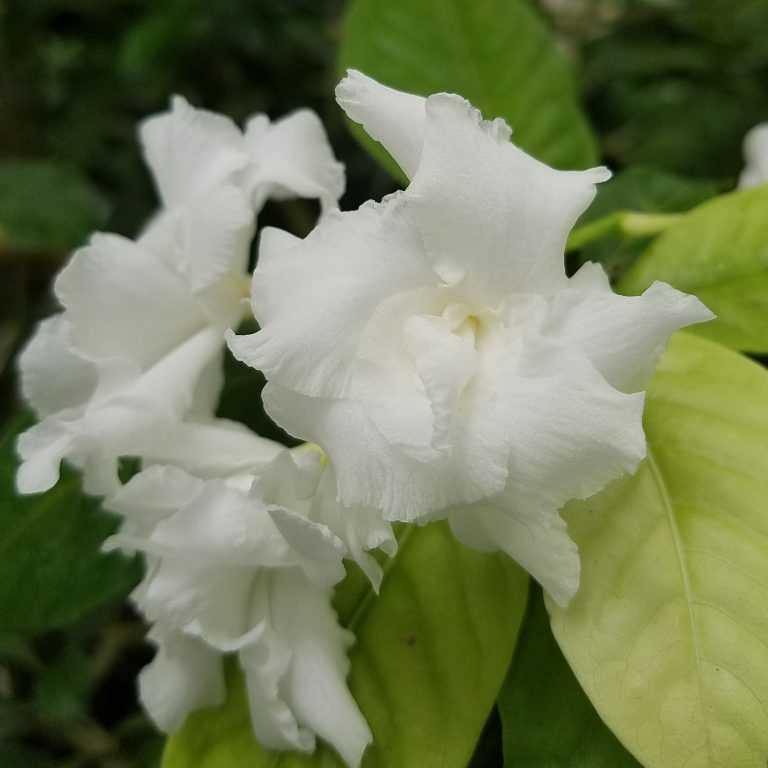- Tabernemontana Care Tips
- Types of Tabernemontana
- 1. Tabernemontana divaricata
- 2. Tabernemontana coronaria
- 3. Tabernemontana heyneana
- 4. Tabernemontana pandacaqui
- 5. Tabernemontana hallei
- 6. Tabernemontana elegans
- 7. Tabernemontana orientis
- Varieties of Tabernemontana
- Growing Tabernemontana Indoors
- Introduction
- Choosing the right variety
- Lighting and temperature
- Watering and humidity
- Fertilizing
- Pruning and maintenance
- Pest control
- Conclusion
- Tabernemontana Propagation Methods
- 1. Seeds
- 2. Stem Cuttings
- 3. Division
- 4. Air Layering
- 5. Tissue Culture
- Common Issues with Tabernemontana
- Pest Infestation
- Disease
- Environmental Stress
- Nutritional Deficiencies
- Leaf Drop
- Tabernemontana Pests and Diseases
- 1. Aphids
- 2. Scale Insects
- 3. Whiteflies
- 4. Leaf Spot
- 5. Root Rot
- 6. Yellowing Leaves
- Tabernemontana: Frequently Asked Questions
- 1. What is Tabernemontana?
- 2. What are some popular types of Tabernemontana?
- 3. How do I care for Tabernemontana plants?
- 4. Can Tabernemontana plants be grown indoors?
- 5. Are Tabernemontana plants toxic?
- 6. How do I propagate Tabernemontana plants?
- 7. How often do Tabernemontana plants bloom?
- 8. Are Tabernemontana plants suitable for beginners?
- 9. Can Tabernemontana plants tolerate drought?
- 10. Are there any pests or diseases that affect Tabernemontana plants?
- About YourSiteName
- Welcome to YourSiteName!
- Explore a World of Knowledge
- Informative Articles
- Engaging and Interactive
- User-Friendly Interface
- Get Involved
- Join Us Today
- Q&A:
- What are the care tips for Tabernemontana plants?
- What are the different types of Tabernemontana plants?
- How often should I water my Tabernemontana plant?
- Can I grow Tabernemontana plants indoors?
- What is the best temperature for Tabernemontana plants?
- How often should I fertilize my Tabernemontana plant?
- Are Tabernemontana plants prone to any pests or diseases?
- Video: Giant flower tree, bloom all year round and how to propagate for many roots
Welcome to YourSiteName, where we provide expert tips and information on caring for various types of plants. In this article, we will be discussing Tabernemontana, a genus of flowering plants that are native to tropical regions. From care tips to different types and varieties, we have all the information you need to know to keep these beautiful plants thriving in your garden or indoor space.
Tabernemontana, commonly known as the milkwood, is a genus that belongs to the family Apocynaceae. These plants are known for their delicate and fragrant flowers, which can range in color from white to pink, yellow, or purple. Tabernemontana plants are typically medium-sized shrubs or small trees, making them a versatile addition to any garden or landscape.
When it comes to caring for Tabernemontana plants, there are a few key tips to keep in mind. Firstly, these plants thrive in well-draining soil, so it’s important to ensure that the soil is not waterlogged. It’s also crucial to provide them with plenty of sunlight, as they require at least six hours of direct sunlight each day to flourish. Additionally, Tabernemontana plants benefit from regular pruning to maintain their shape and promote healthy growth.
There are several different types and varieties of Tabernemontana to choose from, each with its own unique characteristics and care requirements. Some popular varieties include Tabernemontana divaricata, also known as pinwheel flower or crape jasmine, with its white, star-shaped flowers and sweet fragrance. Another popular variety is Tabernemontana coronaria, commonly known as the Easter lily vine, which features clusters of white, trumpet-shaped flowers.
Whether you’re a seasoned gardener or just starting out, Tabernemontana plants can be a beautiful and rewarding addition to your collection. With the right care and attention, these plants will thrive and provide you with stunning blooms and delightful fragrances. Stay tuned to YourSiteName for more plant care tips and information on a wide range of plants and garden topics!
Tabernemontana Care Tips
- Light: Tabernemontana plants prefer bright but indirect light. Place them near a window with filtered sunlight.
- Temperature: These plants thrive in temperatures between 60°F and 75°F (15°C – 24°C). Avoid exposing them to extreme temperatures.
- Watering: Keep the soil evenly moist but not waterlogged. Water the plants when the top inch of soil feels dry to the touch.
- Fertilizer: Feed tabernemontana plants with a balanced liquid fertilizer during the growing season (spring and summer). Follow the instructions on the fertilizer packaging.
- Pruning: Prune tabernemontana plants in spring to maintain their shape and remove any dead or damaged leaves.
- Repotting: Repot tabernemontana plants every 2-3 years using well-draining soil. Choose a pot that is slightly larger than the current one.
- Pests: Keep an eye out for common houseplant pests like mealybugs and spider mites. If you notice any, treat the plants with an appropriate insecticide.
- Propagation: Propagate tabernemontana plants through stem cuttings in spring or summer. Take 4-6 inch cuttings and plant them in moist soil.
- Enjoyment: Tabernemontana plants produce fragrant flowers, so place them in an area where you can enjoy their scent.
Following these care tips will help you keep your tabernemontana plants healthy and thriving. Remember to observe your plants regularly and adjust their care accordingly.
Types of Tabernemontana
Tabernemontana is a genus of flowering plants in the family Apocynaceae. There are several types of Tabernemontana species, which are commonly known as crepe jasmines or pinwheels.
1. Tabernemontana divaricata
Common names: Crepe Jasmine, East India Rosebay
This type of Tabernemontana is native to India and Southeast Asia. It is a popular ornamental plant known for its fragrant white flowers. The flowers have a crinkled surface, resembling crepe paper, giving it the name “Crepe Jasmine”.
2. Tabernemontana coronaria
Common names: Butterfly Gardenia, Carnation of India
Tabernemontana coronaria is native to India and is also widely cultivated as an ornamental plant. It produces white, waxy flowers with a delightful fragrance. The flowers attract butterflies, hence the name “Butterfly Gardenia”.
3. Tabernemontana heyneana
Common names: Buckridge Pinwheel
This species is native to India and Sri Lanka. It is a small, erect shrub with white, pinwheel-shaped flowers. The flowers are highly fragrant and bloom in clusters.
4. Tabernemontana pandacaqui
Common names: Banana Bush, Milo Pine
Tabernemontana pandacaqui is native to the Philippines. It is a tall shrub or small tree with large, glossy leaves and white flowers. The plant gets its common name “Banana Bush” because of the banana-like shape of its leaves.
5. Tabernemontana hallei
Common names: Halle’s Pinwheel
Tabernemontana hallei is a rare species found in Madagascar. It is a small, bushy shrub with glossy leaves and fragrant white flowers. This species is highly valued for its medicinal properties.
6. Tabernemontana elegans
Common names: Elegant Tabernemontana
This species is native to tropical Africa. It is a medium-sized shrub with shiny leaves and white, fragrant flowers. Tabernemontana elegans is often used in traditional medicine for various purposes.
7. Tabernemontana orientis
Common names: Cow-itch Bark
Tabernemontana orientis is native to tropical Africa and Madagascar. It is a small tree with milky sap and white, fragrant flowers. The bark of this plant is used medicinally for its antipyretic and analgesic properties.
| Type | Common Names | Origin |
|---|---|---|
| Tabernemontana divaricata | Crepe Jasmine, East India Rosebay | India, Southeast Asia |
| Tabernemontana coronaria | Butterfly Gardenia, Carnation of India | India |
| Tabernemontana heyneana | Buckridge Pinwheel | India, Sri Lanka |
| Tabernemontana pandacaqui | Banana Bush, Milo Pine | Philippines |
| Tabernemontana hallei | Halle’s Pinwheel | Madagascar |
| Tabernemontana elegans | Elegant Tabernemontana | Africa |
| Tabernemontana orientis | Cow-itch Bark | Africa, Madagascar |
Varieties of Tabernemontana

Tabernemontana is a genus of flowering plants in the Apocynaceae family, which consists of around 120 species. These plants are native to tropical and subtropical regions of Asia, Africa, and Australia. Here are some popular varieties of Tabernemontana:
- Tabernemontana divaricata: Also known as the crepe jasmine or pinwheel flower, this variety is native to India and Southeast Asia. It features white, fragrant flowers that resemble pinwheels, hence the common name. It is a popular plant for ornamental purposes and is often used in landscaping.
- Tabernemontana coronaria: Also known as the moonflower, this variety is native to the Indian subcontinent. It is a perennial shrub with large, white, trumpet-shaped flowers that bloom at night, hence the name. The flowers have a sweet fragrance and attract nocturnal pollinators like moths.
- Tabernemontana ventricosa: Also known as the bladderpod, this variety is native to East Africa. It is a small, evergreen shrub with glossy, dark green leaves and tubular, white flowers that have a strong, sweet fragrance. The flowers are followed by inflated seed pods that resemble bladders, giving the plant its common name.
- Tabernemontana heyneana: This variety is native to India and Southeast Asia. It is a small, bushy shrub with glossy leaves and fragrant white flowers. It is often cultivated for its medicinal properties. The roots and leaves of this plant are used in traditional medicine to treat various ailments.
These are just a few examples of the many Tabernemontana varieties available. Each variety has its own unique characteristics, making them suitable for different gardening preferences and purposes.
| Variety | Common Name | Origin | Flower Color | Fragrance |
|---|---|---|---|---|
| Tabernemontana divaricata | Crepe Jasmine or Pinwheel Flower | India, Southeast Asia | White | Fragrant |
| Tabernemontana coronaria | Moonflower | Indian Subcontinent | White | Sweet |
| Tabernemontana ventricosa | Bladderpod | East Africa | White | Sweet |
| Tabernemontana heyneana | N/A | India, Southeast Asia | White | Fragrant |
Growing Tabernemontana Indoors
Introduction
Tabernemontana, commonly known as pinwheel flower or crepe jasmine, is a beautiful flowering plant that can bring a touch of exotic beauty to your indoor garden. While it is native to tropical and subtropical regions, it can also thrive indoors with the proper care and conditions.
Choosing the right variety

There are several varieties of tabernemontana, each with its own unique characteristics and requirements. When choosing a variety to grow indoors, consider factors such as the amount of light in your home, the temperature, and the size of the plant. Some common indoor varieties include:
- Tabernemontana divaricata: Also known as pinwheel flower, this variety produces beautiful, star-shaped white flowers and has a compact growth habit, making it suitable for smaller indoor spaces.
- Tabernemontana pandacaqui: This variety is known for its fragrant, white flowers with yellow centers. It can grow quite tall, so it’s best suited for larger indoor spaces.
Lighting and temperature
Tabernemontana plants thrive in bright, indirect light. Place your plant near a window that receives bright but filtered light. Avoid placing it in direct sunlight, as this can scorch the leaves. Temperature-wise, tabernemontana prefers temperatures between 65-75°F (18-24°C) during the day and slightly cooler temperatures at night.
Watering and humidity

Keep the soil of your tabernemontana plant evenly moist, but not waterlogged. Water it thoroughly when the top inch of soil feels dry to the touch. During the winter months, reduce the watering frequency slightly, as the plant’s growth slows down. Additionally, tabernemontana prefers a humid environment, so mist the leaves regularly or place a tray of water near the plant to increase humidity.
Fertilizing
To promote healthy growth and abundant flowering, feed your tabernemontana plant with a balanced, water-soluble fertilizer every one to two months during the growing season. Follow the package instructions for the correct dosage.
Pruning and maintenance
Regular pruning helps maintain the shape and size of your tabernemontana plant. Remove any dead or yellowing leaves and trim back any leggy or overgrown branches. This will encourage the plant to produce new growth and maintain a neat appearance.
Pest control
Tabernemontana plants are generally quite resistant to pests. However, they can occasionally attract aphids, mealybugs, or scale insects. Treat any infestations with an organic insecticide or insecticidal soap to protect your plant’s health.
Conclusion
Growing tabernemontana indoors can be a rewarding experience. With the right care and conditions, you can enjoy the beauty and fragrance of these exquisite flowers year-round. Remember to provide adequate light, temperature, water, and regular maintenance to keep your tabernemontana healthy and thriving.
Tabernemontana Propagation Methods
Tabernemontana plants can be propagated through various methods. Here are some common propagation methods for Tabernemontana:
1. Seeds
One of the easiest and most common ways to propagate Tabernemontana is through seeds. Collect mature seeds from a healthy plant and sow them in a well-draining potting mix. Cover the seeds lightly with soil and keep the soil moist. Germination can take a few weeks to a few months, so be patient. Once the seedlings are large enough, transplant them into individual pots.
2. Stem Cuttings
Stem cuttings can be taken from a healthy Tabernemontana plant. Choose a stem that is about 4-6 inches long with a few sets of leaves. Remove the lower set of leaves and dip the cut end in a rooting hormone. Plant the cutting in a well-draining potting mix and keep it in a warm, humid environment. Mist the cutting regularly to maintain humidity. Roots should develop in a few weeks, and once the cutting is rooted, it can be transplanted into a larger pot.
3. Division
Some Tabernemontana species can be propagated through division. Carefully remove the plant from its pot and gently separate the root ball into two or more sections, making sure each section has roots and shoots. Replant each division in its own pot with fresh potting mix. Water the divisions thoroughly and place them in a warm, bright location. Keep the soil moist until the divisions are established.
4. Air Layering

Air layering can be used to propagate Tabernemontana plants with woody stems. Choose a healthy stem and make a small incision just below a node. Apply rooting hormone to the incision. Wrap moist sphagnum moss around the incision and cover it with plastic wrap to create a humid environment. Secure the moss and plastic wrap in place. Roots should develop in a few weeks. Once roots have formed, cut the stem below the new roots and plant it in a pot.
5. Tissue Culture
Tissue culture is a more advanced propagation method that involves growing plant cells in a laboratory. It requires specialized equipment and expertise, so it may not be suitable for the average gardener. However, tissue culture can be an effective method for mass propagating Tabernemontana plants and producing disease-free plants.
Choose the propagation method that works best for your Tabernemontana plant and enjoy growing new plants from your existing ones.
Common Issues with Tabernemontana
Pest Infestation
Pest infestation is a common issue that can affect Tabernemontana plants. Some common pests that can cause problems include:
- Aphids: These small insects feed on the sap of the plant and can cause leaves to wilt and turn yellow. They can be controlled by using insecticidal soap or neem oil.
- Whiteflies: These tiny, white flies can quickly multiply and cause damage to the leaves by sucking sap. They can be controlled by using yellow sticky traps or insecticidal soap.
- Spider mites: These microscopic pests can weave fine webs on the plant and suck the sap, causing leaves to yellow and drop. They can be controlled by spraying the plant with water and using insecticidal soap.
Disease
Tabernemontana plants are generally resilient, but they can still be susceptible to certain diseases, including:
- Root rot: Overwatering or poorly draining soil can lead to root rot, which can cause the plant to wilt and eventually die. To prevent this, make sure the soil is well-draining and water the plant only when the top inch of soil is dry.
- Powdery mildew: This fungal infection appears as a white, powdery coating on the leaves. It can be controlled by improving air circulation and using a fungicide if necessary.
- Leaf spots: Leaf spots are often caused by bacterial or fungal infections. They appear as discolored spots on the leaves. Remove affected leaves and use a fungicide if necessary.
Environmental Stress
Tabernemontana plants can also experience issues due to environmental factors:
- Temperature extremes: Tabernemontana plants prefer moderate temperatures and can suffer damage if exposed to extreme heat or cold. Protect the plant from direct sunlight and provide shelter or move indoors during extreme temperature conditions.
- Drought stress: Underwatering or allowing the plant to dry out can cause wilting and leaf drop. Keep the soil evenly moist, but not overly saturated.
- Improper lighting: Insufficient light can lead to leggy growth and reduced flowering. Place the plant in a location with bright, indirect light.
Nutritional Deficiencies
Tabernemontana plants require adequate nutrients to thrive. Common nutritional deficiencies include:
- Nitrogen deficiency: This can cause yellowing of older leaves. Use a balanced fertilizer that is higher in nitrogen or apply compost to replenish nitrogen levels.
- Iron deficiency: This can cause yellowing between leaf veins. Treat with an iron chelate supplement or use a fertilizer formulated for acid-loving plants.
- Phosphorus deficiency: This can cause stunted growth and purplish coloration. Use a fertilizer with a higher phosphorus content or apply bone meal to the soil.
Leaf Drop
Tabernemontana plants may also experience leaf drop for various reasons:
- Overwatering: Watering the plant too frequently or keeping the soil too saturated can lead to root rot and subsequent leaf drop.
- Underwatering: Allowing the plant to dry out completely can cause leaves to wilt and drop. Keep the soil evenly moist but not overly saturated.
- Environmental stress: Exposure to extreme temperatures, drafts, or sudden changes in environmental conditions can also cause leaf drop. Ensure the plant is in a stable environment with moderate temperatures and good airflow.
| Issue | Cause | Prevention and Treatment |
|---|---|---|
| Pest Infestation | Aphids, whiteflies, spider mites | Use insecticidal soap or neem oil |
| Disease | Root rot, powdery mildew, leaf spots | Ensure well-draining soil, improve air circulation, use fungicide if necessary |
| Environmental Stress | Temperature extremes, drought stress, improper lighting | Protect from extreme temperatures, keep soil evenly moist, provide bright indirect light |
| Nutritional Deficiencies | Nitrogen deficiency, iron deficiency, phosphorus deficiency | Apply balanced fertilizer, use iron chelate or acid-loving plant fertilizer, apply phosphorus-rich fertilizer or bone meal |
| Leaf Drop | Overwatering, underwatering, environmental stress | Adjust watering practices, provide stable environment |
Tabernemontana Pests and Diseases
Tabernemontana plants are generally resistant to common pests and diseases. However, they can still be vulnerable to certain issues. Here are some pests and diseases to watch out for:
1. Aphids

Aphids are tiny insects that feed on the sap of plants. They can cause stunted growth and yellowing of leaves. To get rid of aphids, you can spray a solution of water and mild soap on the affected plant.
2. Scale Insects
Scale insects are another common pest that can infest Tabernemontana plants. They appear as small, waxy bumps on the stems and leaves. To treat scale insects, you can use insecticidal soap or horticultural oil to suffocate them.
3. Whiteflies
Whiteflies are small flying insects that can cause damage by sucking the sap from plants. They can be controlled by introducing natural predators like ladybugs or by using insecticidal soap.
4. Leaf Spot
Leaf spot is a fungal disease that causes dark, irregular spots on the leaves. To prevent leaf spot, avoid overhead watering and make sure there is good air circulation around the plant. If leaf spot occurs, remove and destroy the affected leaves.
5. Root Rot
Root rot is a common problem in Tabernemontana plants when they are overwatered or planted in poorly-draining soil. To prevent root rot, make sure the plant is in well-draining soil and water it only when the top inch of soil feels dry.
6. Yellowing Leaves
Yellowing leaves can indicate a variety of issues, including nutrient deficiencies or overwatering. Check the soil moisture and adjust watering accordingly. If nutrient deficiencies are suspected, a balanced fertilizer can be applied following the manufacturer’s instructions.
By monitoring your Tabernemontana plants regularly and taking appropriate measures, you can keep them healthy and free from pests and diseases.
Tabernemontana: Frequently Asked Questions
1. What is Tabernemontana?
Tabernemontana is a genus of flowering plants in the family Apocynaceae. It consists of various species of evergreen shrubs and small trees that are native to tropical regions of Asia, Africa, and Australia.
2. What are some popular types of Tabernemontana?
Some popular types of Tabernemontana include:
- Tabernemontana divaricata (Crepe Jasmine): Known for its fragrant white flowers.
- Tabernemontana coronaria (Mussaenda Lily): Features showy white flowers with yellow centers.
- Tabernemontana heyneana (Heyne’s Taberana): Native to India and known for its medicinal properties.
3. How do I care for Tabernemontana plants?
To care for Tabernemontana plants, follow these tips:
- Location: Place the plant in a spot that receives bright, indirect sunlight.
- Watering: Water the plant regularly, allowing the top inch of soil to dry out between waterings.
- Temperature: Keep the plant in a warm environment with temperatures between 60-80°F (15-27°C).
- Fertilization: Fertilize the plant monthly during the growing season with a balanced liquid fertilizer.
- Pruning: Prune the plant to maintain its shape and remove any dead or damaged branches.
4. Can Tabernemontana plants be grown indoors?
Yes, Tabernemontana plants can be grown indoors as long as they receive sufficient bright, indirect sunlight. They can make beautiful houseplants, but it’s important to provide them with the right care conditions.
5. Are Tabernemontana plants toxic?
Yes, Tabernemontana plants are toxic to humans and pets if ingested. It’s important to keep them out of reach of children and pets to avoid any accidental ingestion.
6. How do I propagate Tabernemontana plants?
Tabernemontana plants can be propagated through stem cuttings. Take a 4-6 inch cutting from a healthy plant and place it in moist soil or water until it develops roots. Once the roots are well-established, you can transfer the cutting to a pot or garden bed.
7. How often do Tabernemontana plants bloom?
Tabernemontana plants typically bloom in the spring and summer months. However, the exact blooming frequency may vary depending on the species and growing conditions.
8. Are Tabernemontana plants suitable for beginners?
Tabernemontana plants can be suitable for beginners, as they are relatively easy to care for. However, it’s important to understand their specific care requirements and provide them with the right conditions for optimal growth.
9. Can Tabernemontana plants tolerate drought?
No, Tabernemontana plants are not drought-tolerant and require regular watering to thrive. It’s important to keep the soil consistently moist, but not soggy, to ensure the plant’s health.
10. Are there any pests or diseases that affect Tabernemontana plants?
Tabernemontana plants can be prone to pests such as aphids, mealybugs, and scale insects. They can also be susceptible to fungal diseases if the conditions are too moist. Regular inspection and proper care can help prevent and treat these issues.
About YourSiteName
Welcome to YourSiteName!
At YourSiteName, we are dedicated to providing you with valuable information and tips on various topics of interest. Our goal is to help you learn, explore, and discover new things.
Explore a World of Knowledge
With a wide range of topics covered, YourSiteName aims to be your go-to source for reliable and informative content. Whether you are looking for expert gardening advice, travel tips, or cooking recipes, we’ve got you covered.
Informative Articles
Our team of experts curates articles that are well-researched, accurate, and easy to understand. We strive to present information in a clear and concise manner, making it accessible to readers of all backgrounds.
Engaging and Interactive
We believe that learning should be fun! That’s why we strive to create engaging and interactive content that keeps you hooked from start to finish. Our articles are designed to educate, entertain, and captivate your attention.
User-Friendly Interface
Navigating through our website is hassle-free, with a user-friendly interface that allows you to easily find the topics that interest you. Our search feature and well-organized categories ensure that you can quickly find the information you are looking for.
Get Involved
We encourage our readers to actively participate in the YourSiteName community. Feel free to leave comments, ask questions, and share your own personal experiences. We believe that knowledge grows when ideas are shared.
Join Us Today
Start your journey of discovery by exploring our wide range of articles. Whether you are a hobbyist or a seasoned expert, YourSiteName is here to support your quest for knowledge.
Q&A:
What are the care tips for Tabernemontana plants?
Tabernemontana plants require bright but indirect sunlight, well-drained soil, regular watering, and occasional fertilization. It is also important to protect them from extreme temperatures and pests.
What are the different types of Tabernemontana plants?
There are several types of Tabernemontana plants, including Tabernemontana divaricata, commonly known as the crepe jasmine, and Tabernemontana coronaria, also known as the moonflower. Each type has its own unique characteristics and growth habits.
How often should I water my Tabernemontana plant?
Tabernemontana plants should be watered regularly, allowing the soil to dry out slightly between waterings. It is important not to overwater, as this can lead to root rot and other problems.
Can I grow Tabernemontana plants indoors?
Yes, Tabernemontana plants can be grown indoors as long as they receive plenty of bright but indirect sunlight. They can be placed near a window or under artificial grow lights to provide the necessary light for healthy growth.
What is the best temperature for Tabernemontana plants?
Tabernemontana plants prefer temperatures between 65-85°F (18-29°C). They should be protected from extreme heat or cold, as it can affect their growth and overall health.
How often should I fertilize my Tabernemontana plant?
Tabernemontana plants can be fertilized every 2-4 weeks during the growing season with a balanced liquid fertilizer. It is important to follow the instructions on the fertilizer packaging and not to over-fertilize, as this can damage the plant.
Are Tabernemontana plants prone to any pests or diseases?
Tabernemontana plants can be prone to pests such as aphids, mealybugs, and whiteflies. They are also susceptible to fungal diseases if kept in damp conditions. Regularly inspecting the plants and taking appropriate measures, such as using insecticidal soap or fungicides, can help prevent and manage these issues.
Video:
Giant flower tree, bloom all year round and how to propagate for many roots







